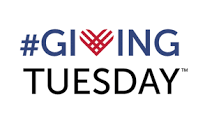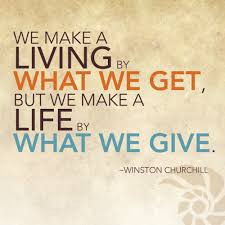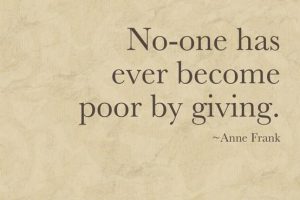Yesterday was “giving Tuesday,” a fairly new idea. And a global movement, I hasten to add. And I’m late, I know; my posts come out on Wednesdays. STILL, this seems a “better late than never” opportunity. So here we go.

As I write this on Monday night, I see that over $300,000,000 in gifts has been raised online from 2,500,000 gifts. I’m impressed.
So impressed I thought about making my Culture of Philanthropy post from 2016 — also called “Four Steps to Adapting a Philanthropic Mindset” [forms an acronym that spells BAIL. Surely something can be done with that.] — my contribution towards making your donation move along a bit smoother. You’re welcome.
Originally posted on December 16, 2016
![]()
I was raising money for a symphony orchestra in Ohio when Ronald Reagan gutted the National Endowment for the Arts, somewhere during the 1980s.
Good for me (career-wise); bad for the country.
I was new to philanthropy in those days, both professionally and personally. I had entered the fundraising field as a part-time Assistant to the Director at a battered woman’s shelter while I finished writing my master’s thesis (The Relationship Between Resources and Responsibility, for the curious among us). It soon became apparent that the assistance the director needed was fund raising. So, I set about to learn how.
Philanthropy was new to me personally too. I’d grown up the only child of a single mom who worked for a labor union (i.e., Democrat). I certainly never saw my mother give any away.

But once it became my job to raise money for nonprofits, I quickly came to understand the importance of what fundraisers affectionately call “unrestricted operating income.” Most organizations would crumble if everyday people with a checkbook stopped giving.
From 1984 to 1986 I was Development Director for a Metropolitan Orchestra. I took to my first full-time job with gusto, joining the local fundraisers’ professional organization, subscribing to the journals that publish the research, and even reading them. Yes, there are people who research this stuff.
There was data on how to get the receiver to open the envelope. At least there was back then.
You’d think we in the U.S. might be #1 in charitable giving. But, this map, Place in the world giving index, from the Charities Aid Foundation (CAFonline.org) says differently:
The Americas are on the left, Europe and Africa in the center, and Asia and Australia to the right.

Some day I’d like to write more (i.e., learn more) about how various internal structures of a country affect its philanthropy. Do capitalist countries give more than socialist countries? Do countries with a strong safety net give less than countries without one? Do countries with higher GNP give more than poorer countries? I can think of a number of hypotheses that would be fun to follow. But, alas . . .
I say this by way of introduction to today’s topic: Philanthropy
More specifically, the culture of philanthropy. How does one assure a culture that enables philanthropy? How important is it? Are there specific steps one can take to develop a culture of philanthropy within the average American family?
Throughout our history, we’ve had an Andrew Carnegie, multiple Rockefellers and Fords, and now Warren Buffet and Bill Gates — the philanthropists who built our libraries and hospitals and art museums. But from where did the idea of expecting relatively small checks from many individuals hatch? And when? I wish I knew.
According to my own anecdotal investigation, the vast majority of people who give today are descended from people who gave yesterday. It’s a learned behavior, a duty one adopts early on from those around you. You don’t think about it much; you just do it. In other words, it’s cultural.
But what if you didn’t come out of that culture?
Can philanthropy be taught?
I don’t mean in the “teaching math” sense of teaching it. I mean it in the “how do we pass along the value of philanthropy to a new generation?” sense of the word.
And so, in honor of what I hope will become an annual “It’s Time to Ante Up the Contribution Dollar” post, I give you …
The Four Steps to Adapting a Philanthropic Mindset
(for those of us not born into such a tribe)
1. Believe that charitable giving is a noble and worthy endeavor.
Giving is the acknowledgment that in order for certain things to happen in the world you inhabit, you need to participate. You need to take a stand, be counted, raise your hand, say “Here I am.” It is the belief that however small your gift, it matters. Because you matter.
2. Aspire to become part of something larger than yourself and your small tribe.
Contributing gives the opportunity to be part of something larger than your relatively small circle. It’s the chance to expand your reach. And, we mustn’t forget, if the organization thanks you appropriately, it lets you rub elbows with others of similar ilk.
3. Identify the organizations that further the values you hold, and support them.
Here’s where you begin to speak out (click here for the post on Speaking Out with Your Checkbook). And, here’s where the organization has a responsibility to you. They need to make it easy to give to them: Click here. Use the enclosed envelope. Make your check out this way.
You, too, have a responsibility: to do your homework. Which organization will you choose? How will you choose?
4. Learn as much as you can about how the organization functions.
There is nothing worse than a disgruntled, resentful donor. (Well, I’m sure there are many things worse; but at the moment, none come to mind.) You want to feel good about your giving, feel that you are making a difference, no matter how small.

Don’t forget to use Charity Navigator, the organization I mentioned in How I Chose, that does impressive things with data on 8,359 charitable organizations. Use them to help you decide.
Four Steps: Believe, Aspire, Identify, Learn.
Unfortunately (or maybe not) you could make BAIL from these four. Surely there’s a joke there.

What’s your relationship with philanthropic giving? Was it modeled for you as a child growing up? Or have you followed a different path?
[box] Interested in reading At Home on the Kazakh Steppe? I hope so. It would make an excellent gift, she said in all seriousness.
Click here for the PAPERBACK and eBook versions.
Amazon makes it easy. And, you can always order it from your local independent bookstore.
Reviews are more important to authors today than ever before. If you’ve read it and enjoyed it, please consider leaving a review on Amazon or Goodreads. Short reviews are just as valuable as long ones. [/box]
Merril Smith
I don’t know if people necessarily come to charitable giving through a family background, but I’m sure some do. Don’t many religious organizations have charities? I’ve never been part of one, but that’s the way it seems. I can’t remember my mom giving to any organization. My father may have after he became a professor.
I guess my husband and I started once we had a little bit of income–public TV/Radio campaigns, charities through work, and then expanding to other organizations that we believe in. When older daughter applied to Bryn Mawr, there was an option of giving to a charity of her choice in lieu of a application fee. She chose Broadway Cares/Equity Fights AIDS (but the donation came from us).
Janet Givens
Those Public TV and radio fund drives can reel us in, can’t they. Did you know they once lasted just one day? Which then leads me to the question, who “should” support public television and radio? The public at large (i.e., taxes) or those who use it?
Marian Beaman
I agree with Anne Frank: No one has ever become poor by giving. In fact, it works the opposite way: “The liberal soul shall be made prosperous.”
Last week I mentioned giving to the less fortunate through charities, but since this week’s emphasis is on the arts, I’ll mention that we support the Jacksonville Symphony and of course our local PBS station. How else could I watch Downton Abbey with good conscience – ha!
Giving was modeled for me all through childhood. Grandma Longenecker spent hours and hours sewing for the poor for decades and my mother did the same through the Bossler Mennonite Church sewing circle. And of course Aunt Ruthie opened her home to immigrants and refugees for decades, the most generous gift of all.
You are way more involved than I charitably, Janet, and I continue to be amazed at your careful research for each of these posts. Happy Holidays to you, Woody, and the gang.
Janet Givens
Your comment reminds me that I my grandmother had a practice of giving. She gave so much, on her meager salary as a nurse (before nurses made good money) the story goes, that she got audited. When the two IRS men came, she brought out a batch of shoeboxes with her receipts carefully saved, and they turned around and left.
Marian Beaman
Oh, my gosh, what a story, Janet.
Maybe your next book can feature your grandmother and other assorted family members each with a story to tell – wow!
Janet Givens
Yes, my grandmother will be in my next memoir. Thanks for the nod, Marian.
Janet Morrison
I love that story!
Frank V Moore
I don’t specifically remember my (lower middle-class, both working) parents giving money to organizations — other than what went into the collection basket at church every Sunday — but, I vividly remember my dad’s significant involvement as a volunteer with our church’s St. Vincent de Paul Society which helped poorer members of the parish. That may be attributable to the fact that it was the inspiration/source for my middle name. And even when I left NASA and had my own consulting business, I performed a number of pro bono studies and activities for Accomack County. Hmmmmm …. I’m beginning to think my volunteerism may be motivated more by some deep seated psychcological need than my dad’s role model behavior. Whatcha think, Janet?
And even when I left NASA and had my own consulting business, I performed a number of pro bono studies and activities for Accomack County. Hmmmmm …. I’m beginning to think my volunteerism may be motivated more by some deep seated psychcological need than my dad’s role model behavior. Whatcha think, Janet?
I hadn’t thought about it until now, but I suspect my dad’s volunteer work is probably what led me to become what I often jokingly refer to as a “professional volunteer”. One might conclude I’ve even gone so far as to start organizations just so I could volunteer.
Janet Givens
Whatever deep seated psych need it may be, Frank, more of us could use one just like it. I’m glad my post got you remembering good times.
I’m glad my post got you remembering good times.
Mildred LaBeur
I was a secret donor cause you never saw the dollar bill I stuffed into the bell-ringing Salvation Army Santa bucket. Probably twice every season.
Janet Givens
Your secret is safe with me, Ma.
Laurie Buchanan
Janet — I donate MONEY to Covenant House. I donate TIME to a suicide hotline.
For many people the holidays are an especially gut-wrenching season. For U.S. readers who might find it helpful, here is the number for the National Suicide Prevention Lifeline 800-273-TALK (8255).
Janet Givens
Thank you for this, Laurie.
As Kathy Pooler wrote in her recent post, Christmas can set up “an expectation that everyone is happy and healthy.” And, when expectations are not met, the fallout can indeed be devastating.
Tim Fearnside
We support several non-profits, but none more than our daughters’ independent school, where I serve on the board. (Board service is a great way to go broke, I’ve learned). Fortunately, it’s a great school, and one I firmly believe in. Which brings me to my point, which is that education, itself, can be a great way to foster an attitude toward giving in young people.
My daughter’s school considers itself a “progressive” school, which has a lot of meanings, but can often be summed up under three broad principles: (1) some sort of emphasis on project-based or “experiential” learning, (2) an emphasis on the child’s social and emotional development, or a “whole child” approach, and (importantly) (3) an emphasis on social justice and/or community service. Elements (2) and (3), if done well, help develop socially responsible kids who are involved in their communities, want to make a difference in the world, and believe they can. It’s a very cool thing to see in action, particularly in today’s mad world. Anyway, just thought I’d toss that into the mix, as well, fwiw :).
Janet Givens
Thanks for your comment, Tim. It’s prompted me to go off on a slightly different direction. With your daughters in private school, how do you feel about public education and, in particular, the potential new head of the Dept. of Education? Would you like to see more school choice across the country? A weakening of traditional public education? I believe that is the direction we’ll be going under the new administration.
I should add here my own bias: Both my husbands were products of a private secondary school education and, frankly, I generally feel I got a better foundation from my public school in East Orange, NJ. (Go, Panthers).
I had to smile at your comment about going broke as a member of the Board. Whoever is doing the fundraising for your school knows what s/he is doing. For if your BOARD doesn’t support the program, how can you expect others, not as closing aligned to support it? (I’m sure you’ve heard the rationale; it just comes out automatically, like riding a bicycle).
Whoever is doing the fundraising for your school knows what s/he is doing. For if your BOARD doesn’t support the program, how can you expect others, not as closing aligned to support it? (I’m sure you’ve heard the rationale; it just comes out automatically, like riding a bicycle).
Tim Fearnside
Hey Janet, I was a public school kid, myself. They were decent, for the most part, although their one-size-fits-all model, at the time, wasn’t well-suited to my learning style. Of course, nobody cared about learning styles in those days. You either got with the program or didn’t. I mostly didn’t.
I do feel strongly about public education, despite my daughters being in private school, and wish we invested more in our public schools. I’m not opposed to the concept of charter schools, and know there are some good ones out there. But I also know they often underperform and can be self-defeating. I’m generally opposed to the privatization of public services, like schools, and wouldn’t get near most for-profit institutions.
I’m often a bit hesitant to talk about my daughters’ school, since it is private, and I know that comes with a good bit of stigma. But I do believe they’re getting it mostly right. And I do very much love that the school is free to teach, explore, and encourage thought, discussion, and involvement around social justice issues, something public schools don’t always have the liberty to do, for various reasons.
Last week, my oldest daughter had a birthday party, in which she forsook presents in lieu of donations to the humane society. None of her friends batted an eye at this, and it makes me hopeful about the generations coming up behind ours.
Janet Givens
Thanks for that, Tim. It sounds like the school is very lucky to have you on board.
Your comment about a private school being better able to teach topics that public schools are not, reminded me of a young student at Woody’s granddaughter’s Waldorf School. As you may know, the Waldorf system is big on building self esteem. Woody was at the school to observe a Thanksgiving ceremony where the kids sat in a circle and went around to announce to all just what they were thankful for. This was in the south, keep in mind, so this little fella’s turn comes (he’s maybe seven) and he stands up and is so proud to announce in a deep southern accent, “I’m thankful for mistakes.”
Do they teach that in public schools? It’d be great if they did.
Have a joyous holiday.
How To Stay Informed in This Age of Fake News – Janet Givens
[…] off goal with a three-part Examining My Political Story, ending just before last Christmas with The Culture of Philanthropy. I wanted to address the questions that had been swirling around in my head. Now, a year later, I […]
kathleen pooler
Good question, Janet. I routinely give to my church, Food for the Poor, our local Rescue Mission and whatever else I feel called to help as it comes up. It’s always a good thing to stay in touch with those who are less fortunate than ourselves. Thanks for another detailed lesson. You always approach your topic with such gusto and wisdom.
Janet Givens
Thanks Kathy. Appreciate the support
Janet Givens recently posted…The Culture of Philanthropy
susan scott
A thought provoking post Janet thank you. Sometimes it’s a tricky thing .. who and what to give to? Donations to Save the Rhino, Save the Elephant, Yemen, Church, Cancer Association, the Homeless, the Destitute, Foodbanks, SPCA? – the list goes on and on, and on. There’s a thing called donor fatigue that I sometimes suffer from. South Africans are a generous people – and are always willing to lend a helping hand whether bank notes into a collection, or food stuffs outside the supermarket or whenever and wherever the immediate need is…
Janet Givens
Donor fatigue, good term. I feel it too at times. Donor request fatigue even more often. That’s why I decided back after our big election in 2016 to go at my giving in a more thoughtful way. And why I was so pleased to find Charity Navigator. They take the guesswork out of giving and have helped me become a proactive donor, rather than a reactive (impulsive?) donor. No more guilt — my new motto. Thanks for stopping be, Susan.
Janet Givens recently posted…The Culture of Philanthropy
Bette Stevens
Shocking statistics, Janet… Sharing. In our family, we were raised to believe and be an active participant of “a sharing is caring” society. That should be part of everyone’s job description.
Bette Stevens recently posted…MY MAINE “Winter Tales” (Haiku selections) from Bette A. Stevens’s WIP
Janet Givens
Thank you Bette. Your comment reminded me of something my grandmother often said— the more you give, the more you get back. There is something magical that happens around that idea. Love your “sharing is caring” society.
Janet Givens recently posted…The Culture of Philanthropy
Rachael Stray
This was such in interesting read. The reasons people give to charities etc varies. Many people give after something personally has happened to them eg an accident so they raise money for the Air Ambulance.
Rachael Stray recently posted…Dining out in Durham – tapas and tasty treats
Janet Givens
That personal connection does seem so important, yes. Thanks for adding your voice here Rachel.
Janet Givens recently posted…The Culture of Philanthropy
Carol Taylor
I also think many people give because of a tradgedy that has happened. I gave up giving long ago to big charities and now give money , time and goods to a mothers and childrens home. A group of us have donated sewing machines, materials etc and we go once a week and show the ladies how to make and sew…The idea is once they have had their babies that they will be able to either work from home or in the gift shop the home has. Some of the craft items they make are really lovely. The ladies themselves are displaced and have come from Burma but are not recognised by the Thai government. The home and school is run by a religious order so far they have built a school for the children and locally through the womens club I am in we help raise money and other organisations also donate it is growing into a thriving little community which is lovely to see.
Carol Taylor recently posted…The Culinary Alphabet…The letter K…
Janet Givens
How cool that you can be so involved, Carol. I’d think that would greatly enhance the sense of connection to the group. Sounds like they are lucky to have you. And you them.
Janet Givens recently posted…The Culture of Philanthropy
Pamela
This is a fascinating and educational post, Janet. I don’t have much to add – you cover it so well. The only other thing I’m thinking is that philanthropy must also come from a passion – something that you believe in strongly enough that you want to help that cause continue/improve by giving it your hard-earned dollars. And you need to have great trust and hope in that organization.
But also, some of the wealthy who give philanthropically don’t feel the sting of giving away “hard-earned dollars” (they were born into wealth) and give because their accountant says it will help them pay less in taxes in the end. ;-0
Pamela recently posted…On the Last Day
Janet Givens
Hi Pam. I imagine there are many motivations to give. Just this morning I realized how much more important it has become to support those organizations we believe in. But passion? I’m wondering if thinking we need passion first prevents some from donating? So many hypotheses, so little time. Many thanks for your ongoing support.
Janet Givens recently posted…The Culture of Philanthropy
Janet Morrison
My parents taught me giving by example. We were active in our church and I was taught to tithe from my weekly allowance as a small child. If not taught this practice from a young age, I wonder if I would have embraced it as an adult. I’ll never know.
Janet Givens
Similar to my experience, Janet. My grandmother tithed, and taught me the more we give, the more we have. She believed that and I’ve come to see it in my own life. Thanks for sharing your story.
Janet Givens recently posted…How Do You Enter A Room?